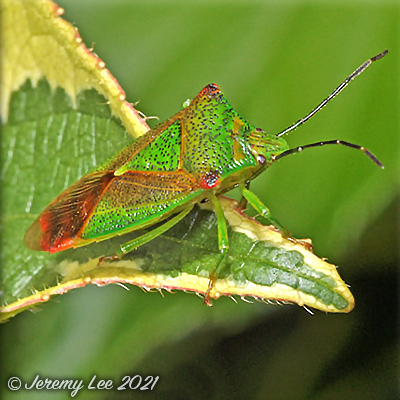
 |
|
Scientific Classifications explained » Amphibians » Ants » Aphids » Bees » Beetles » Birds » Bugs » Butterflies » Caterpillars » Damselflies » Dragonflies » Earwigs » Flies » Frog/Leafhoppers » Fungi » Galls » Grasshoppers » Harvestmen » Hoverflies » Lacewings » Ladybirds » Leaf Mines » Lichens » Mammals » Millipedes » Mosses » Moths » Sawflies » Slugs » Snails » Spiders » Trees » Wasps » Wild Flowers » Woodlice |
UK Nature > Bugs > Acanthosoma haemorrhoidale

Scientific Name: Acanthosoma haemorrhoidale Common Name: Hawthorn Shield Bug Acanthosoma haemorrhoidale is a colourful and a fairly distinctive species, although confusion with the smaller and less elongate Birch Shieldbug (Elasmostethus interstinctus) is possible. The lateral extensions of the pronotum are larger in A. haemorrhoidale, and are marked with red, while the scutellum is green and the abdomen frequently red-tipped. Overwinters as an adult, emerging and mating in the spring. The larvae occur May-October, feeding mainly on hawthorn berries, although a range of other deciduous trees are also used, inlcuding oak, hazel and birch. The new generation is complete from August/September or even later; adults may become darker before hibernation. Common and widespread in mixed woodlands across Britain and Ireland, becoming scarce in Scotland. |
|

https://www.uknature.co.uk is a website dedicated to showing the immense diversity of UK nature and wildlife. Our vast range of habitats, from lowland arable to snow covered mountains, from storm-ravaged coastlines to peaceful inland freshwater lakes and rivers, from dry, sandy heaths to deciduous and coniferous forests, all these habitats contribute to the abundance of UK nature. We have wild birds in huge numbers either residing or visiting our shores (597 recorded species as at July 2013) and we must also not forget the humble back garden with its grass lawns, flower beds filled with nectar rich flowers, shrubs and trees, all designed to attract huge numbers of insects such as bees, moths, butterflies and hoverflies; and finally the small ponds which provide safe havens for frogs, toads, newts and even slow worms and grass snakes. www.uknature.co.uk is the showcase for my personal passion, photographing uknature in all its glory. I sincerely hope you all enjoy the fruits of my labours. This site and all images contained therein is © Jeremy Lee 2004 - 2021. All Rights Reserved. Site design by Jeremy Lee. Site development & IT Support by Stuart Lee. |